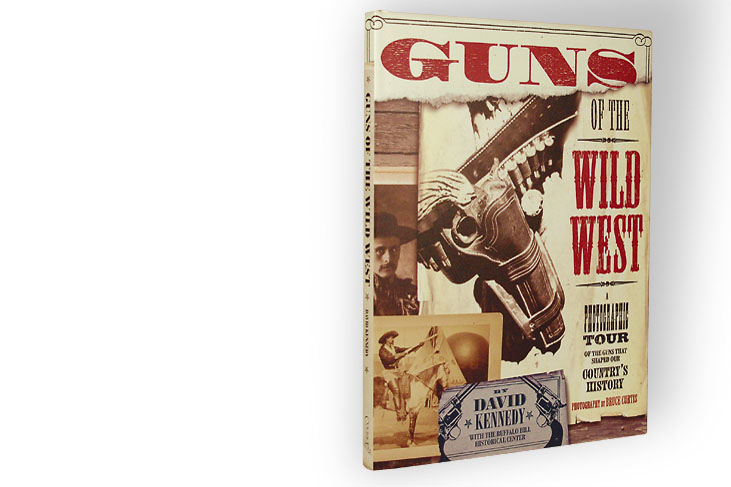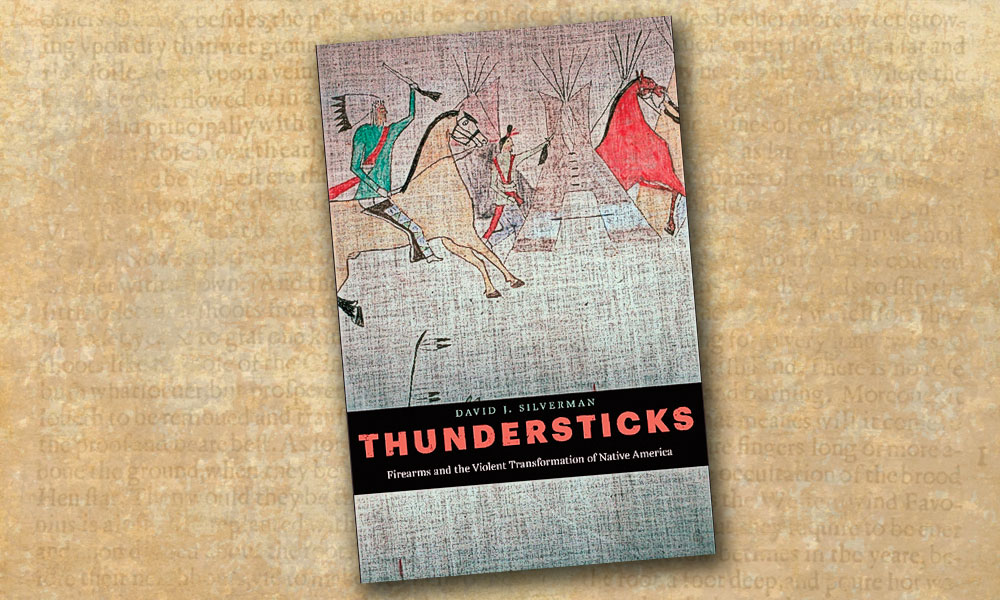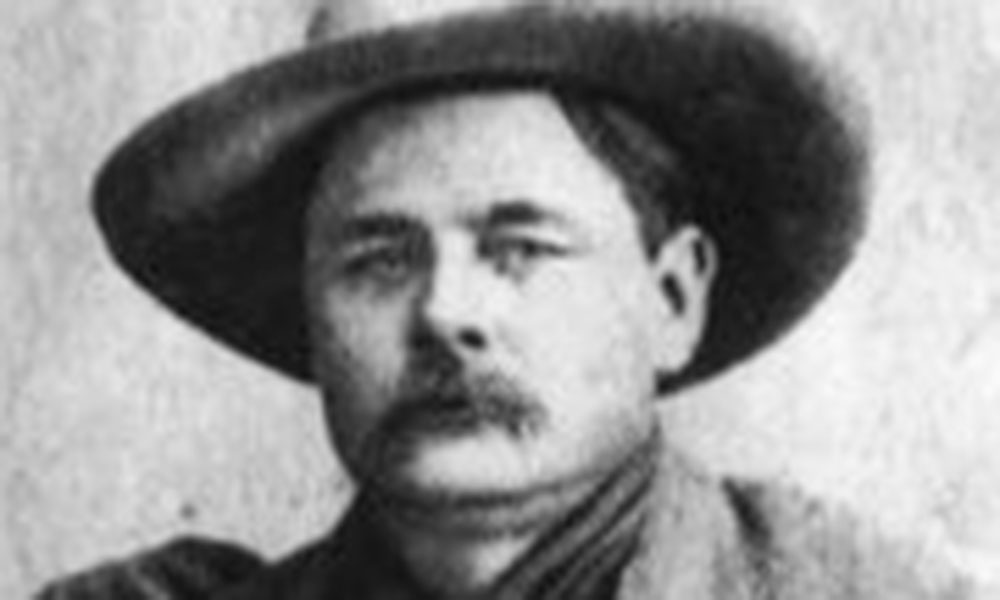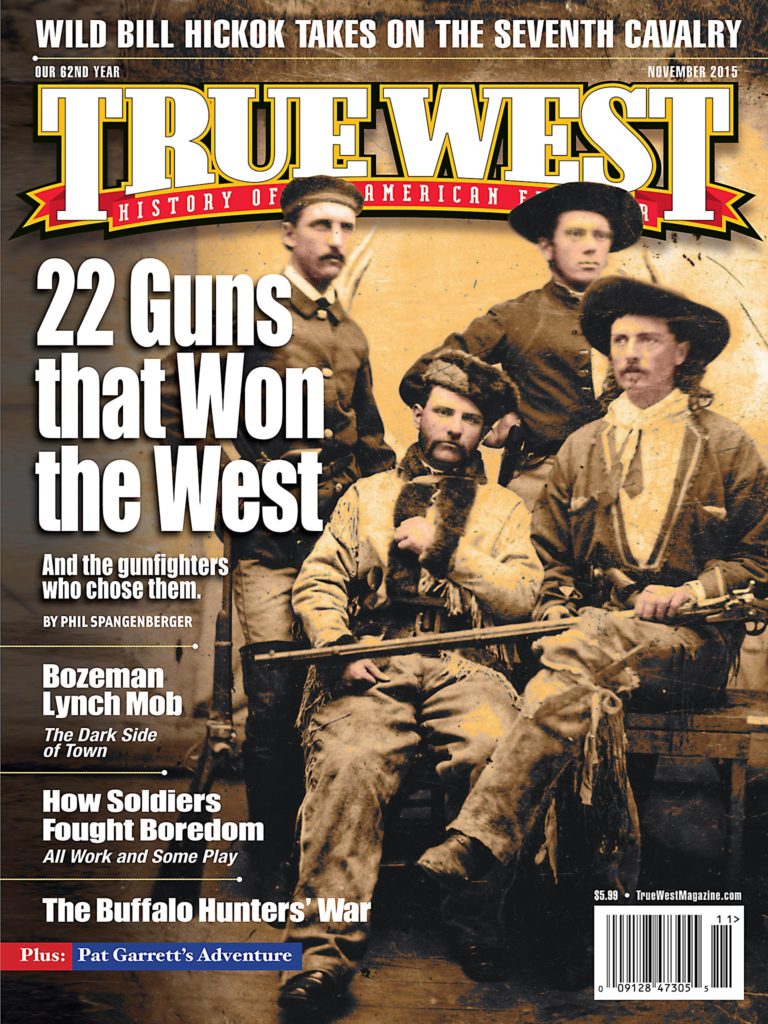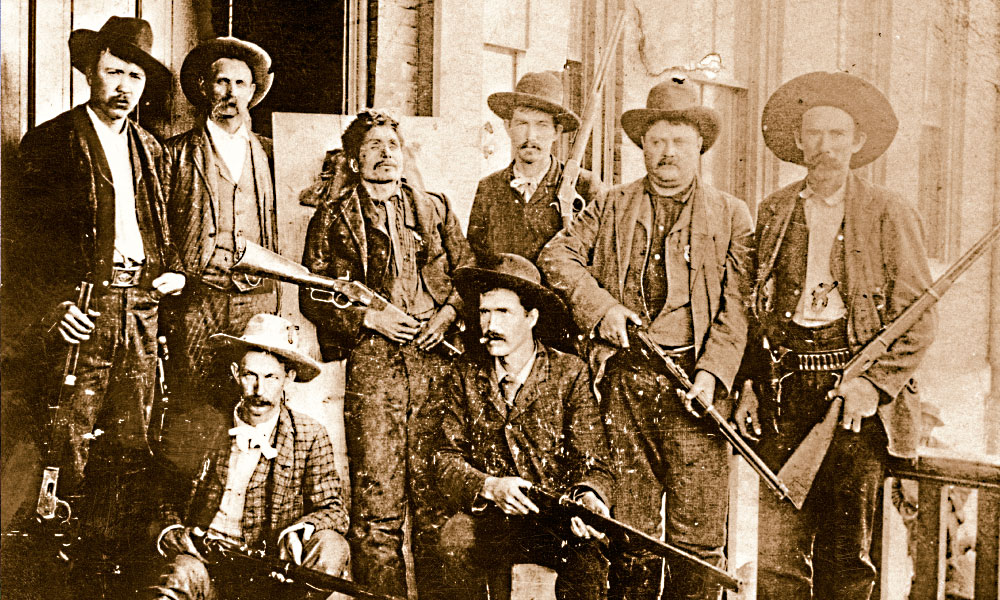
– True West Archives –
The “Gun That Won the West” is a subject that many firearms and Old West aficionados love to discuss and debate. Was the so-called West-winning gun given this coveted title because of the great numbers in which it was produced, or for the work it accomplished? Or was it simply because of who used it during those tumultuous times known as the Wild West? Although some firearms manufacturers advertise their lead-dispensing products as having rightfully earned that distinguished title, such a claim is not to be taken as gospel. While some folks feel that a single model firearm was most responsible for taming our raw frontier in the late 19th century—such as the 1873 Winchester repeater, 1874 Sharps buffalo rifle, double-barreled shotgun, or perhaps The Peacemaker, the legendary 1873 Colt Single Action Army revolver—most serious students of the American West agree that it was not a single model gun or type of firearm that “won the West.” Rather, they believe it was an assortment of rifles, shotguns and handguns, in the hands of a diverse and colorful crowd of men and women, that brought both violence and law and order to our Western territories.
While there were hundreds of different makes and models of firearms used to tame the frontier, let’s take a brief look at a double-deuce—just 22—of the more famous and infamous guns from the Old West, along with some of the good, and the bad, men and women who painted the canvas of America’s Wild West in such bold and vivid colors.
1 / Colt Paterson Revolver
Patented in 1836 and manufactured circa 1837 or 1838 until around 1840, the Paterson Colt was the first practical “revolving pistol,” and revolutionized handguns for all time. Despite its failure as Samuel Colt’s first firearms business venture, this percussion five-shooter gained fame when it was put to deadly use against the Comanches by the early Texas Rangers, most notably by Ranger John Coffee Hays when he used a pair of them to successfully hold off an overwhelming party of Comanches in 1841, during what became known as Hays’ Big Fight at Enchanted Rock. The Paterson went on to see service in Florida’s Second Seminole War (1835-1842), the Mexican War (1846-1848) and during the California Gold Rush. The .36 caliber Paterson, with barrels up to 12 inches long, earned the sobriquet of the “Texas Paterson.”
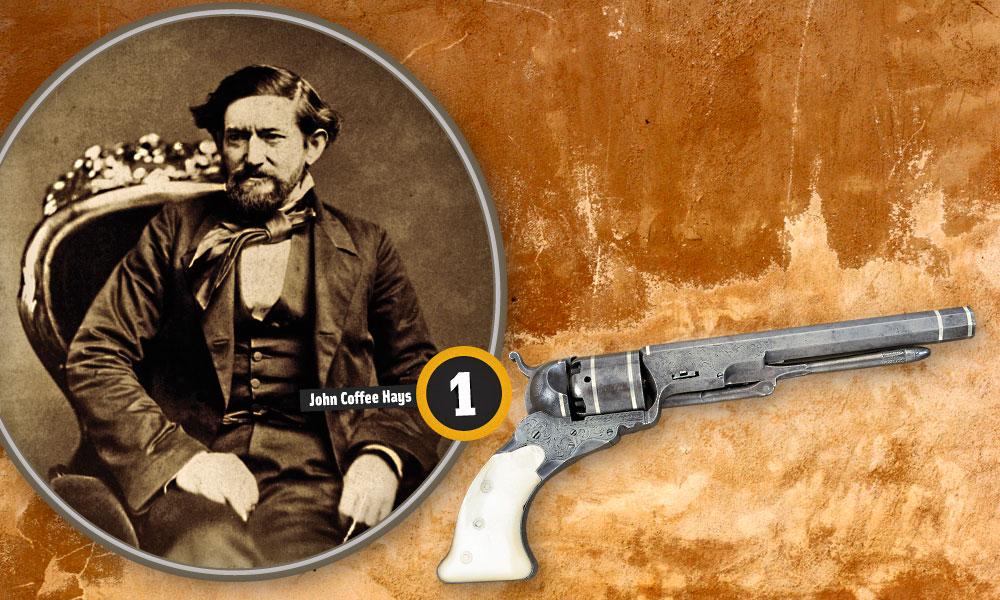
– Photo-Courtesy Library of Congress/Firearm-Courtesy Little John’s Auction Service-By Paul Goodwin –
More commonly known as the “Mississippi Rifle” because of its use by Jefferson Davis’s Mississippi volunteers in the Mexican War, this handsome percussion muzzle-loader was also known in its time as the Windsor, Whitney or Yager (adopted from the German word jaeger for hunter). Considered one of the more handsome of military percussion longarms with its brass patchbox and mountings, this .54 caliber rifle was issued to the Regiment of Mounted Rifles in the 1840s (later the 3rd Cavalry) and favored by Confederate sharpshooters in the War Between the States. Buffalo Bill Cody claimed to have carried and used one during an 1850s cattle drive.
3 / 1847 Colt Walker Revolver
Although only around 1,100 revolvers were ever produced in1847, too late to have much impact on the Mexican War, and despite its number of mechanical deficiencies, Colt’s largest six-shooter, weighing 4 pounds, 9 ounces unloaded, remains a milestone in handgun development. This behemoth .44 cap and ball’s power, accuracy and great range helped spread the word of Col. Colt’s “repeating pistols,” and put him back in the gun business after his Patent Arms Manufacturing Company (manufacturing the Paterson revolver) failed in 1842. Texas Ranger Captain Sam Walker helped design the Walker as an improvement of the Paterson. Colt personally sent him a pair of Walker Colts, which he used effectively before he was killed while leading his troops in the battle of Huamantla, Mexico, in October 1847.
4 / 1851 Colt Navy Revolver
Considered by many to be the best balanced, smoothest handling and handsomest of cap and ball six-guns, nearly a quarter million of these .36 caliber revolvers were made between 1850 and 1873. Named for the Republic of Texas Navy, it was one of the more popular sidearms—with both North and South—during the Civil War. (Confederates made several copies for southern troops.) By the 1870s many Navies were converted to take .38 caliber metallic cartridges and for decades the Colt Navy was one of the most popular handguns in the West. Known as the favored six-gun of James Butler “Wild Bill” Hickok, other noted users include Col. Robert E. Lee, during his service with the 2nd U.S. Cavalry in Texas in the 1850s; John Wesley Hardin; the James-Younger gang; the Pawnee scouts; Maj. Frank North; Tiburcio Vasquez and the Pinkertons.
5 / 1852 & 1853 Slant-Breech Sharps Carbine
The U.S. military purchased more than 15,000 of both models, with most of the ’52 carbines going to the 2nd U.S. Dragoons serving on the frontier. The 1853 model was nicknamed the “John Brown Sharps,” for his use of them in his bloody anti-slavery crusade. They were also called “Beecher’s Bibles,” after anti-slavery minister Henry Ward Beecher was quoted as saying there was more moral power in one Sharps carbine than in 100 Bibles. Both sides favored this percussion arm in “bleeding Kansas” and the 1850s border wars. Government mail contractors and stage lines operating in the Southwest of the era relied heavily on the Sharps; “Pathfinder” John C. Fremont carried a pair of them in his fifth and final Western exploration. The sporting model rifles were used by the early buffalo hunters and both models were also made as shotguns.
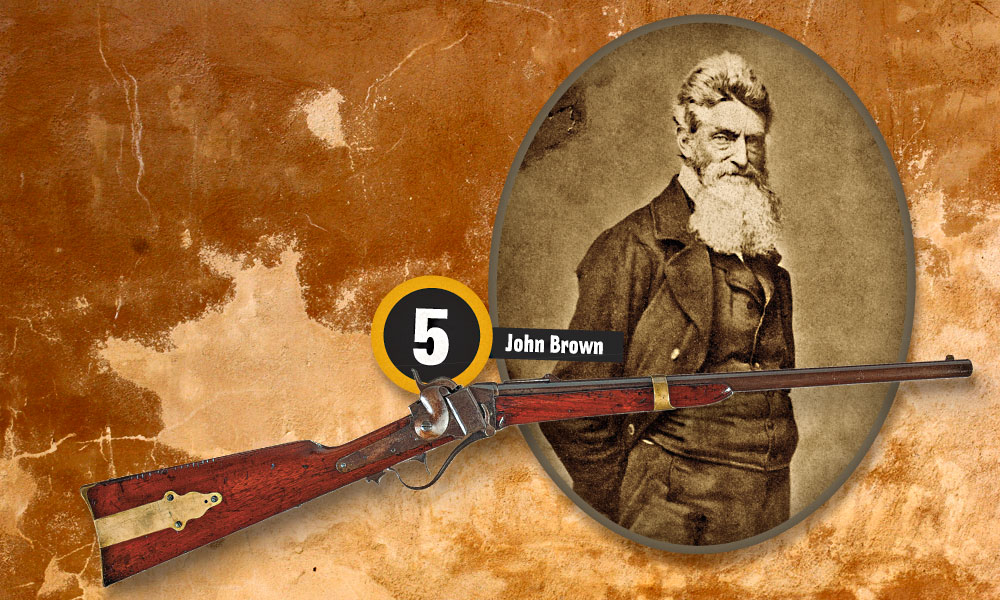
– Firearm-True West Archives/Photo-Courtesy Library of Congress –
6 / Colt’s Dragoon Revolvers
More than 21,000 of Colt’s first, second and third models were turned out between 1848 and 1860, with their massive, heavy and powerful “revolving horse pistols” especially favored by Western horse soldiers and civilians alike. A goodly number of these big six-shooters made their way to the California gold camps with miners as well as by bandit Joaquin Murrieta and his men, and later by California outlaw Tiburcio Vasquez. Others saw service with the Texas Rangers, and pistoleer “Wild Bill” Hickok was known to have owned one and may have used it in 1865 to kill Dave Tutt in Springfield, Missouri.
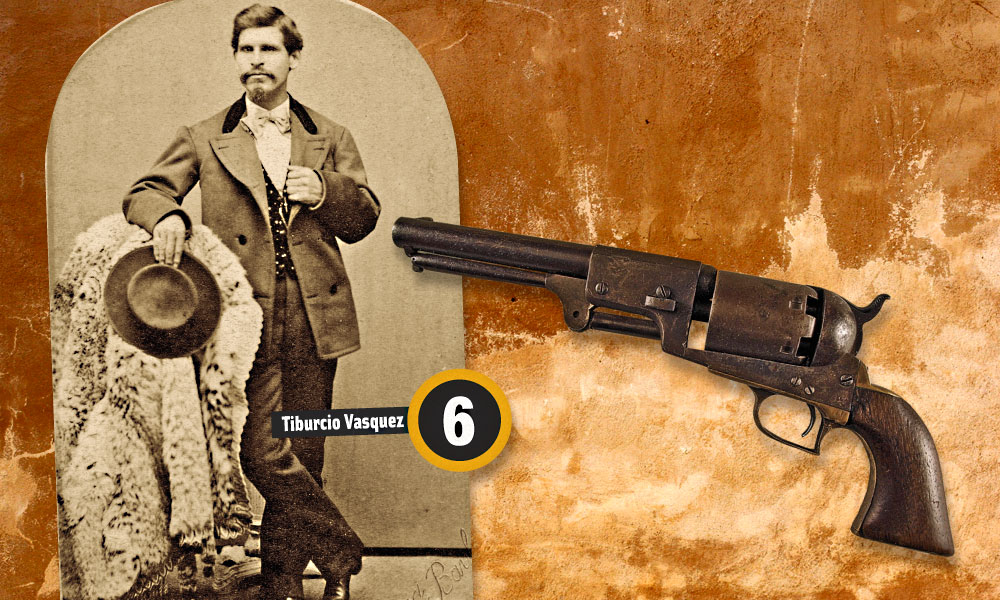
– Photo-Courtesy Robert G. McCubbin Collection/Firearm-Courtesy LA Plaza de Cultura y Artes/John
Boessenecker Collection –
7 / 1860 Colt Army Revolver
The 1860 Colt Army was the primary revolver used by federal troops during the Civil War with about 200,500 produced from 1860 through 1873. Whether in cap and ball or converted to metallic cartridge, this .44 six gun saw much use west of the Mississippi. As the successor to the big Dragoons, this sleek and handsome hogleg packed plenty of power but was easier to handle. Colt’s ’60 was used by the U.S. Cavalry, the Texas Rangers and General Ben McCulloch’s Texas Confederates, Wells Fargo detective James Hume, Mormon “Avenging Angel” Porter Rockwell, El Paso City Marshal Dallas Stoudenmire, the James brothers, Wes Hardin, Sam Bass and scores of good and bad men alike.
8 / Smith & Wesson Model 3 Revolver
Introduced in 1870, this .44 caliber “American” single-action six-shooter stands as the first practical big-bore, metallic cartridge revolver and laid the groundwork for future successful top-break S&Ws like the .44 Russian, .45 Schofield and the Double Action Frontier models. Issued to the U.S. Cavalry for a short while, the Model 3 was also favored by William F. Cody, El Paso City Marshal Dallas Stoudenmire and General William J. Palmer, builder of the Denver and Rio Grande Railroad. The Model 3’s identical-looking “Russian” variation in .44 S&W Russian caliber was packed by John Wesley Hardin, James-Younger gang member Charlie Pitts, Sheriff Pat Garrett and gunslinger King Fisher.
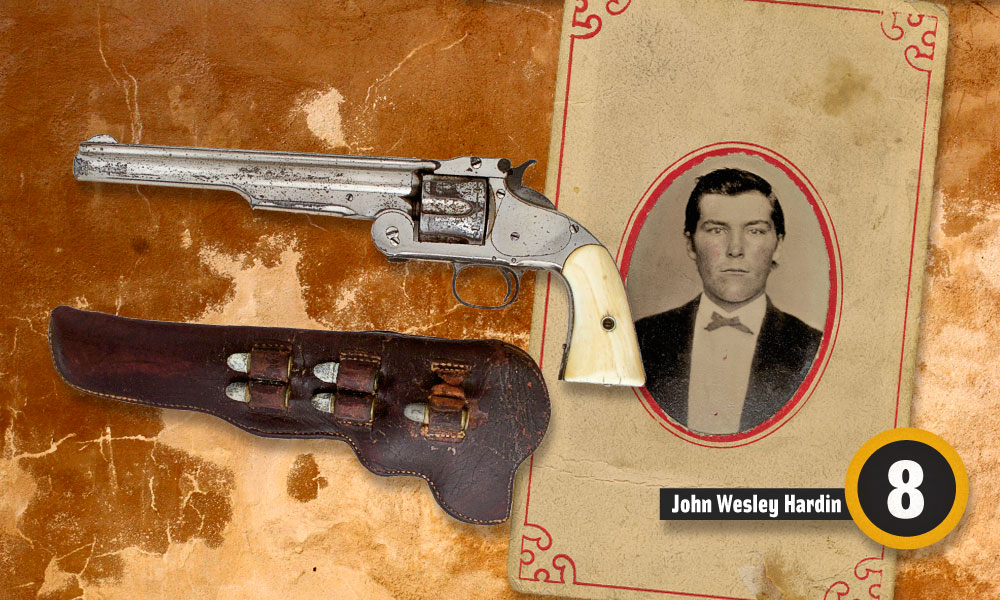
– Firearm & Holster-Courtesy C.B. Wilson, John H. Wilson Collection/Photo-True West Archives –
9 / Henry Deringer Pocket Pistol
If there was ever a single gun that had an impact on the history of the West, it was the vest pocket Deringer pistol used by John Wilkes Booth to assassinate President Abraham Lincoln. The single shot fired by this .41 caliber caplock unleashed an unfriendly federal policy on the Southern states, which added to the frustration of devastated ex-Confederates and caused great numbers of Southerners to head west in search of a new life. Thousands of them were packed in the gold camps of California or concealed on the persons of riverboat gamblers and soiled doves, as well as respectable citizens. Available in a variety of sizes from palm-sized to larger belt pistols, it was the smallest model that helped coin the generic term “derringer,” meaning a small, hideout pistol.
10 / 1866 Winchester Rifle
Originally dubbed the “Improved Henry” because of improvements like the addition of the King’s Patent loading gate on the receiver’s right side (rather than being loaded from the magazine’s muzzle end), a fully enclosed magazine and a wood forearm, over 170,000 of these brass-framed .44 caliber lever-actions left the factory between 1866 and 1898, long after stronger centerfire ammunition had eclipsed the ’66’s weaker rimfire fodder. Whether in full rifle or carbine form, the so-called Yellowboy ’66 was a favorite with California Sheriff Harry Morse; many Native Americans, including Sioux medicine man Sitting Bull; and Custer’s favorite Arikara scout, Bloody Knife; along with members of the Powell Geographic Expedition of the Grand Canyon in 1869; and 1890s outlaw Bill Doolin, to name a few.
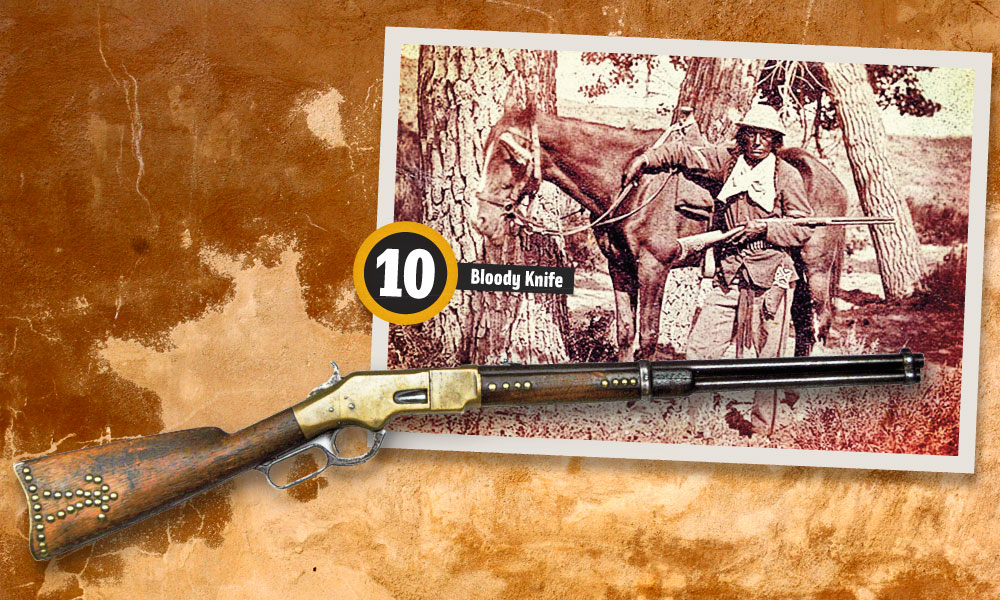
– Photo & FIrearm-Courtesy Glen Swanson Collection –
11 / Springfield Allin Conversion 1866 Rifle
At the close of the Civil War, the federal government converted thousands of 1863 Springfield percussion rifle/muskets from muzzle loaders to breechloaders able to handle self-contained metallic cartridges, first in .58 rimfire, then by lining the
.58-bore barrels to .50 caliber centerfire. Dubbed the “needle gun” because of its long firing pin, it is credited with the U.S. Army’s ability to withstand attacks along Wyoming’s Bozeman Trail in the Hayfield and the Wagon Box fights in 1867 and paved the way for later trapdoor rifles and carbines like the 1873 Springfield. This powerful single-shot arm was employed by the hide hunters during the early post-Civil War buffalo hunting years. Buffalo Bill killed hundreds of the shaggy beasts for meat and affectionately called his .50-70 Allin Springfield “Lucrezia Borgia,” because like the renaissance-era femme fatale duchess, Cody considered it beautiful but deadly.
12 / Double-Barrel Shotgun
Although the rifle and six-gun usually take the bows for winning the West, it was the double-barreled shotgun as much as any firearm that was responsible for bringing civilization to the frontier. Many of the early pioneers invested everything they had, in order to make the overland trek out West, leaving little money for weaponry. The best and certainly one of the most economical and versatile firearms for hunting and defense in a wild, hostile land was the twin-barreled scattergun. Whether muzzle loader or breech-loading cartridge gun, many thousands of shotguns from a variety of makers and countries were the mainstay of settlers, lawmen, express companies, Native Americans, soldiers, ranchers and hunters. Gunmen like Indian Territory lawman Heck Thomas and gambler John H. “Doc” Holiday also used scatterguns. Virtually everyone, good or bad, who needed a weapon recognized the value of the old side by side.
13 / 1873 Colt Single Action Army Revolver
If any gun conjures up images of the Old West, it’s Colt’s 1873 single-action Army revolver. This smokewagon was the best balanced, ergonomically perfect six-gun of the age, and from the time of its introduction in late 1873, it became an instant frontier favorite with good and bad hombres alike. Originally designed and used as a cavalry sidearm, it quickly became the choice of cowboys, lawmen, outlaws and outdoorsmen of all breeds. Produced in many powerful chamberings, most notably .45 Colt and .44-40, it outsold all competitors with 192,000 made by the end of the 19th century. Also known as the Equalizer, Hogleg, and other monikers, it was best known as the Peacemaker—a moniker given it by Colt distributor E. Kittredge of Cincinnati. It was the preferred sidearm of Wyatt Earp, Bat Masterson, the Texas and the Arizona Rangers, John Selman, Wes Hardin, the Daltons, John Slaughter, Elfego Baca and countless other Westerners. It was and still is truly the six-gun of the Wild West.
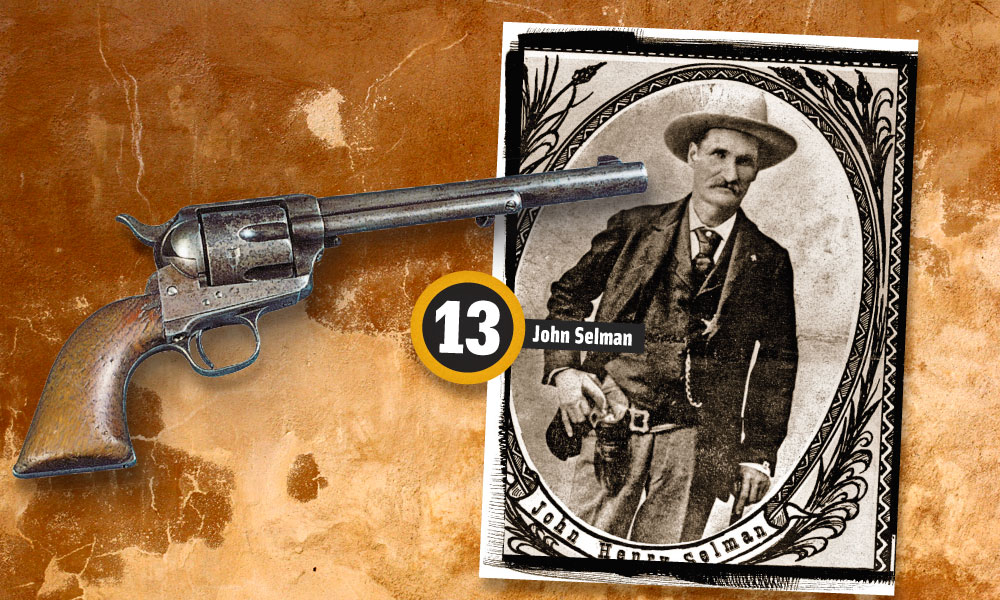
– Photo & Firearm-Courtesy Phil Spangenberger Collection –
14 / 1873 Winchester Rifle
Perhaps the most famous and certainly the most recognizable rifle of America’s frontier period, this iron-framed lever-action rifle was Winchester’s first centerfire arm and was manufactured from 1873 until1919, with well over a half million turned out by 1900. A favorite with Westerners since its debut, the ’73 was eventually teamed with the Colt Single Action revolver and other six-guns of the time that had been chambered to take the Winchester’s proprietary .44-40, .38-40 and .32-20 ammunition. Easy to operate and care for, its slab-sided design made both the rifle and carbine versions ideal for a saddle scabbard, and the ’73 repeater was the premier choice of the post-1874 Texas Rangers, as well as a favorite of Pat Garrett, William F. Cody, Montana rancher Granville Stuart, and outlaws Butch Cassidy, Belle Starr, Pearl Hart and Billy the Kid (William Bonney), just for starters.
15 / 1874 Sharps Rifle
Best known as the “buffalo rifle,” due to its heavy use by hide hunters, it was made from 1871 until 1881.Sharps’ 1874 model didn’t get the ’74 moniker until after the introduction of later Sharps rifles. Only 12,445 of the various model 1874 Sharps were produced by the factory, with several hundred additional ’74-style guns converted from altered Civil War percussion carbine actions by the Sharps factory and by E.C. Meacham of St. Louis. It was offered in such powerful big-game loads as .44-77, .45-70, .50-90 and .50-110. An 1887 government survey cited the Sharps single-shot rifle with shooting more buffalo than any other gun during the hide-hunting years of 1867 through 1882. It also did more to destroy the Plains Indians’ nomadic way of life than any other firearm. Among its famous users were lawman Bill Tilghman, during his buffalo hunting years; the Union Pacific Railroad; and Martha “Calamity” Jane Canary. At the Battle of Adobe Walls in June 1874, hunter Billy Dixon used a .50-90 Sharps to make a 1,538-yard shot, dropping an Indian and effectively ending that fight. To the Indians, the Sharps was known as the “shoots far,” or “shoot today, kill tomorrow” gun.
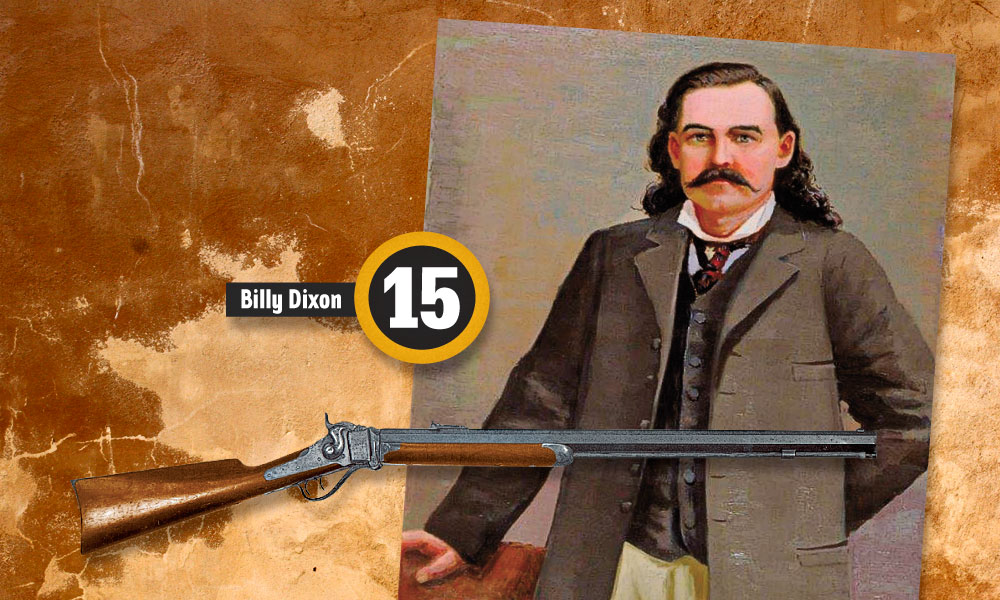
– Painting-Courtesy Panhandle-Plains Historical Museum/Firearm-True West Archives –
16 / 1875 Remington Revolver
When E. Remington & Sons, of Ilion, New York, introduced its “New Model 1875” or “No. 3 Revolver,” a Colt Peacemaker lookalike, the firm had high hopes of competing with the ’73 Colt’s instant popularity, and while sales were initially brisk, the revolver never achieved the desired success or official acceptance by the U.S. government. Chambered in .44 Remington Centerfire, .44 Winchester Central Fire (.44-40) and .45 Colt, only around 25,000 of the model were ever produced from 1875 through 1889. It did gain some popularity out West with the Republic of Mexico ordering 1,000 revolvers during the 1880s, and in 1883 the U.S. Interior Department purchasing 639 nickel-plated 7 1/2-inch ’75 Remingtons for issuance to various Indian Police agencies on frontier reservations. Gunman Frank Loving carried one, but perhaps the 1875 Remington’s most notable proponent was Missouri outlaw Frank James.
17 / 1876 Winchester Rifle
A giant of a rifle, this enlarged version of the ’73 model, the 1876 Winchester was originally dubbed the Centennial Model, with nearly 64,000 produced between 1876 and 1897. Designed as a big-game hunting rifle, it was chambered for more powerful black powder loads than the medium-powered ’73 model, including the .40-60, .45-60, .45-75 and .50-95. The massive ’76 was a favorite with Theodore Roosevelt, and he used it extensively during his Dakota Territory ranching days. The 1876 Winchester is one of the few lever-action rifles to actually see use on the buffalo ranges by the hide hunters. Its unique full-stocked carbine (in .45-75 caliber) was issued to Canada’s North West Mounted Police and used by them into the early 20th century.
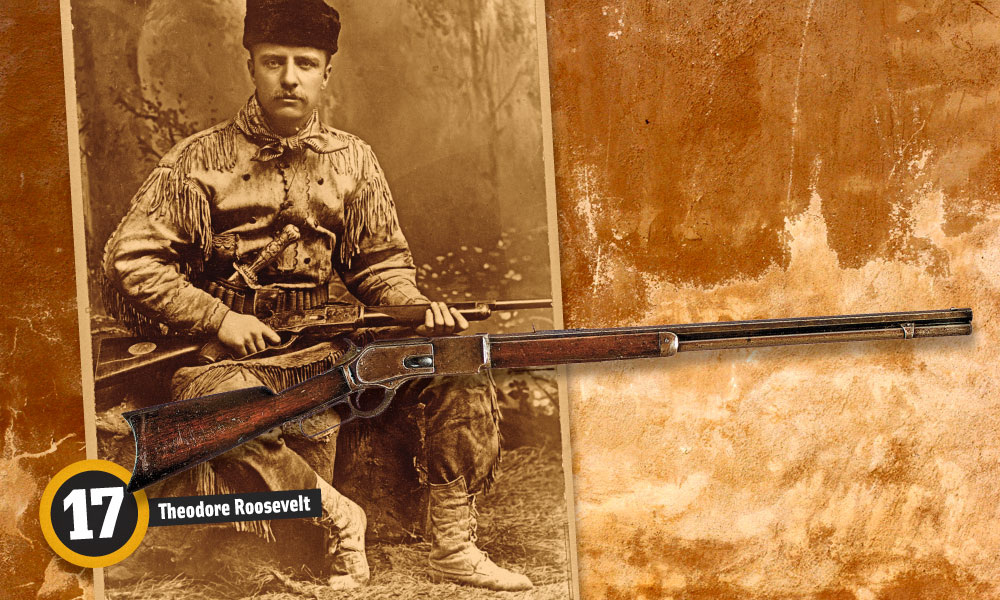
– Firearm-Rock Island Auctions/Photo-Courtesy Library of Congress –
18 / 1877 Colt Double-Action Revolver
Although Colt’s first attempt at producing a double-action revolver was less than stellar due to a complex and inefficient lockworks that was easily broken and difficult to replace, the 1877 model was light and handy and gained a fair amount of popularity on the frontier. Nearly 167,000 were made between 1877 and 1909. In new condition the ’77 was an efficient arm but, if the six-gun was put to much work, the inherent weaknesses in its design became all too obvious. Initially called the “New Double Action, Self Cocking, Central Fire, Six Shot Revolver” by the factory, Colt distributor B. Kittredge of Cincinnati coined the more colorful nicknames of Lightning for the .38 Colt caliber and Thunderer for the .41 Colt chambering (a couple hundred were also made in .32 caliber). Notable ’77 packers included Pat Garrett, Billy the Kid, John Wesley Hardin, Cole Younger and lady bandits Belle Starr and Pearl Hart.
19 / 1886 Winchester Rifle
A vast improvement over the 1876 model, the ’86, with its vertical locking bolts and streamlined frame, was distinctively different from previous Winchesters, and was the first repeater from inventive firearms genius John M. Browning to be adopted by Winchester. It was also that company’s first lever gun to be chambered for the powerful .45-70 Government cartridge, along with other black powder big-game chamberings, such as .45-90 and .50-110 Express. As such it was one of the big-bore repeaters that helped spell doom for single-shot rifles. Another of Teddy Roosevelt’s favorites, it was also a crucial part of Arizona’s Commodore Perry Owens’ arsenal as well as army scout Al Seiber’s. A number of ’86s were used by the “invaders” brought in by the cattlemen in Wyoming’s 1892 Johnson County War. Produced from 1886 through 1935, around 120,000 were turned out by 1900.
20 / 1887 Winchester Shotgun
This early repeating shotgun, first introduced in the West in the spring of 1888, was not the first repeating scattergun manufactured but is considered the first successful one. The brainchild of John Browning, the ’87 lever-action was available in 10 and 12 gauge. The six-shot ’87 quickly became a success with just fewer than 64,000 turned out before 1899. A favorite of Arizona Sheriff John Slaughter, this smoothbore was also used on Feb. 15, 1900, by lawman Jeff Milton, who used his 10-gauge 1887 Winchester shotgun to kill Three Fingered Jack Dunlop during an attempted holdup of the Southern Pacific Railway in Arizona Territory. The Denver & Rio Grande Railroad also issued a number of ’87s to its messengers.
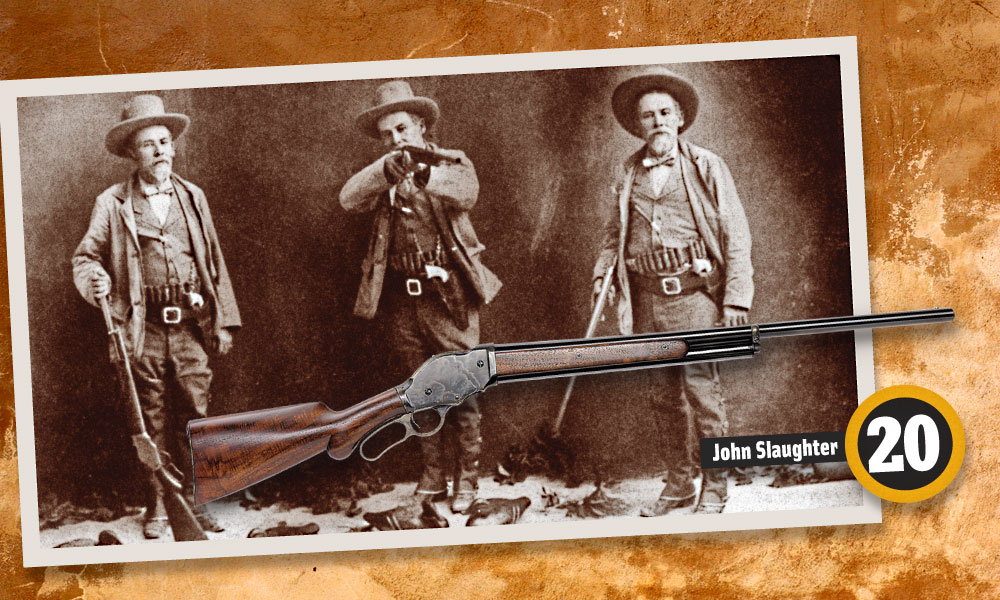
– Photo-True West Archives/Firearm-Courtesy Rock Island Auction Company –
21 / 1892 Colt New Army & Navy Revolver
One of the early swing-out cylinder, double-action revolvers, the 1892 Colt’s cylinder revolved counter clockwise (unlike the company’s earlier single-action six-guns). Although it wasn’t introduced until 1892, with a total production of around 291,000 guns, about 115,000 of them were turned out before the end of 1898 in a series of models with minor internal improvements and dubbed the 1892, 1894, 1895 and 1896 models, and later the Model 1901 and Model 1903. Besides their use by the U.S. Army and Navy, including Teddy Roosevelt and many of his Rough Riders in the Spanish-American War of 1898, several were purchased by Wells Fargo & Co. and the gun was packed by conman extraordinaire Jefferson “Soapy” Smith during his Skagway, Alaska, days.
22 / 1895 Winchester Rifle
Another unique firearm from the inventive genius of John Browning, the 1895 Winchester was the first successful box-magazine lever-action rifle manufactured. Made to handle the then-new smokeless powder ammunition capable of taking big-game worldwide, with chamberings such as the .30-40 Krag, .30-06, .303 British, .40-72, .405 Winchester and the 7.62mm Russian calibers, its box magazine, located beneath the frame, held five rounds. The ’95 model became standard issue with the Arizona Rangers, and was also popular with the Texas Rangers of the era. A few were put to use by some of Theodore Roosevelt’s Rough Riders in Cuba during the Spanish-American War. With nearly 426,000 Model ’95s made between 1896 and 1931, the gun quickly became so popular that almost 20,000 were produced before Jan. 1, 1899.
https://truewestmagazine.com/true-west-best-of-the-west-2018-firearms/


